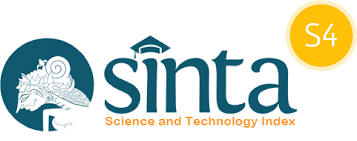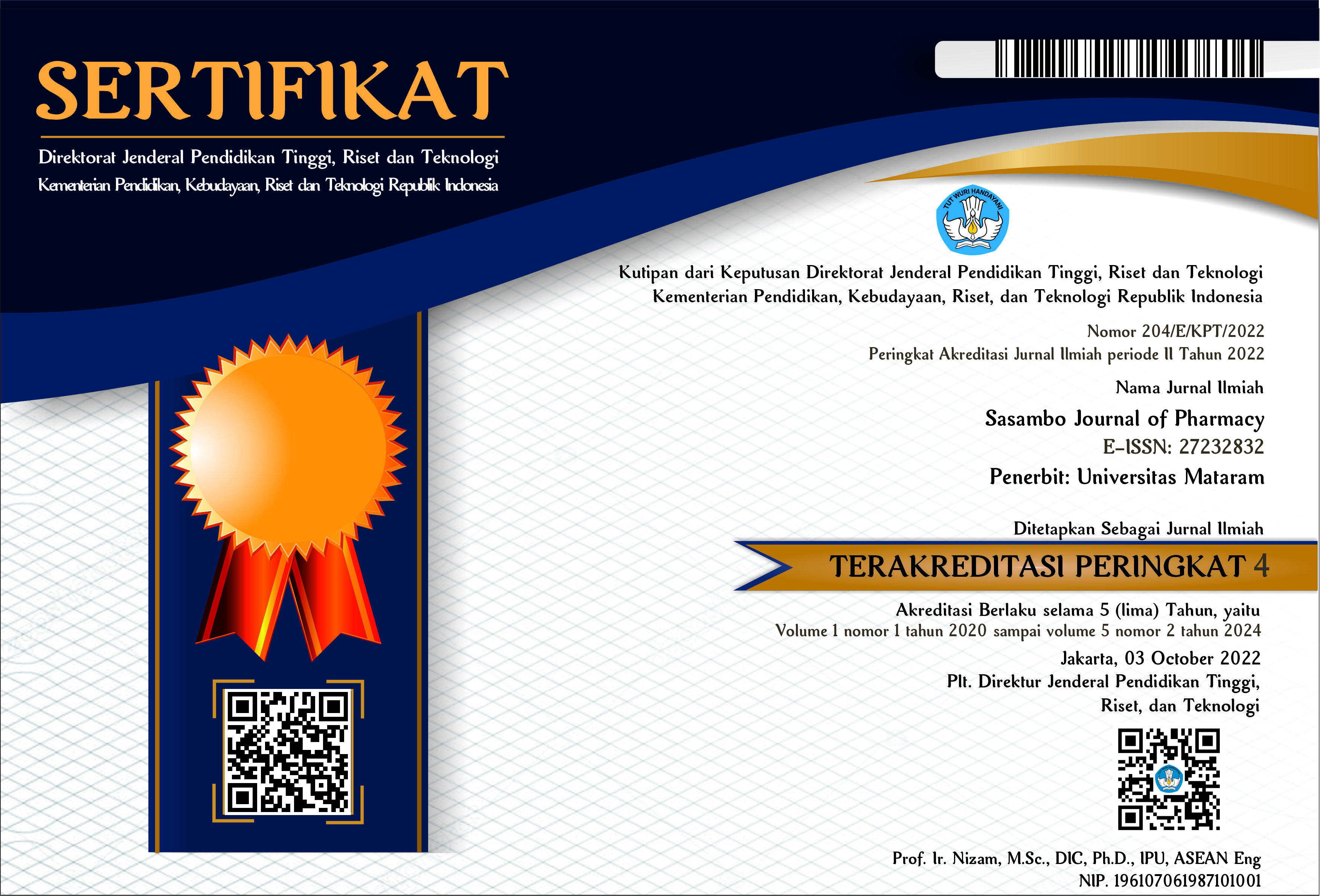Penetapan rendemen dan kandungan kimia ekstrak daun katuk (Sauropus androgynus (L.) Merr.) berdasarkan perbedaan metode pengeringan
DOI:
10.29303/sjp.v3i2.177Downloads
Abstract
Katuk leaves contain chemicals in the form of alkaloids, triterpenoids, saponins, tannins, polyphenols, glycosides and flavonoids, so they are widely used as antioxidants. One factor can affect in chemical content and yield extract is the drying method. The purpose of this study was to determine the effect of different drying methods on yield and chemical content of katuk leaf extract. This research method was experimental Posttest Only Design. Katuk leaves were dried using wind, oven, sun and continued by maceration with ethanol 96% as solvent. The macerate was filtered and air-dried to thick extract which was calculated yield and tested chemical content form of polyphenols, alkaloids, flavonoids, saponins, tannins and terpenoids. Yield data analysis was carried out using One Way ANOVA test. The average yield value of katuk leaf extract in the wind-dry drying method was 11.86±0.23%, the sun was 12.26±0.70%, the oven was 13.64±0.74%. One Way ANOVA test showed significant differences in wind and oven drying, sun and oven drying. Phytochemical screening of each drying showed the presence of polyphenols, alkaloids, flavonoids, saponins, tannins and triterpenoids. The conclusion of this study was that the drying method affects the yield of katuk leaf extract but has no effect on chemical content.
Keywords:
katuk leaves, yield, chemical content, drying methodReferences
Alim, N., Jummah, N., & Pratama, A.S., 2021. Skirining Fitokimia Ekstrak Etanol Kulit Buah Sirsak (Annona muricata Linn) Dan Uji Aktivitas Antioksidan Dengan Metode DPPH. Sasambo of Journal Pharmacy, 2(2), 60-64. DOI: 10.29303/sjp. v2i2.40.
Apsari, D.P., Aprilianto, M.N., Desyani, N.L., & Widayanti, N.P., 2021. Pengaruh Metode Pengeringan Terhadap Senyawa Bioaktif dan Aktivitas Antioksidan Pada Herba Suruhan (Peperomia pellucida L.). Jurnal Ilmiah Ibnu Sina. 6(2): 302-311. DOI: 10.36387/jiis.v6i2.731
Azzahra, F. & Budiati, T., 2022. Pengaruh Metode Pengeringan Dan Pelarut Ekstraksi Terhadap Rendemen Dan Kandungan Kimia Ekstrak Daun Alpukat (Persea americana Mill.). Medical Sains, 7(1), 67-78. DOI: 10.37874/ms.v7i1.285
Azwanida, N. N., 2015. Review on the Extraction Methods Use in Medicinal Plants, Principle, Strength and Limitation. Medicinal and Aromatic Plants, 4(3), 1–6. DOI: 10.4172/2167-0412.1000196
Chairunnisa, S., Wartini, N. M., & Suhendra, L., 2019. Pengaruh Suhu dan Waktu Maserasi terhadap Karakteristik Ekstrak Daun Bidara (Ziziphus mauritiana L.) sebagai Sumber Saponin. Jurnal Rekayasa dan Manajemen Agroindustri, 7(4), 551-560. DOI: 10.24843/JRMA.2019.v07.i04.p07
Christina, I. A. M., Kencana, I. N., & Permana, I. D. G. M., 2018. Pengaruh Metode Pengeringan dan Jenis Pelarut terhadap Rendemen dan Kadar Kurkumin Ekstrak Kunyit (Curcuma domestica Val). Jurnal Ilmiah Teknologi Pertanian Agrotechno, 3(2), 319-324. DOIâ€
DOI: 10.31764/lf.v2i2.5493
Dahlan, S.M. 2012. Statistik untuk Kedokteran dan Kesehatan. Edisi Kelima. Jakarta: Salemba Medika.
Dharma, M. A., Nocianitri, K. A., & Yusasrini, N. L. A., 2020. Pengaruh Metode Pengeringan Simplisia Terhadap Kapasitas Antioksidan Wedang Uwuh. Jurnal Ilmu dan Teknologi Pangan, 9(1), 88-95. DOI: 10.24843/itepa.2020.v09.i01.p11
Diah, F.N., 2017. Formulasi Krim Ekstrak Daun Katuk (Sauropus androgynus (L.) Merr.) Sebagai Antioksidan Dengan Variasi Emulgator Anionik Dan Nonionik. [Skripsi]. Surakarta, Universitas Setia Budi. https://e-dokumen.com/document/1ef7_formulasi-krim-ekstrak-daun-katuk-sauropus-setia.html
Febrina, L., Rusli, R., & Muflihah, F., 2015. Optimalisasi Ekstraksi dan Uji Metabolit Sekunder Tumbuhan Libo (Ficus variegate Blume). Journal of Tropical Pharmacy and Chemistry, 3(2), 74-81. DOI: 10.25026/jtpc.v3i2.153
Fahmi, N., Herdiana, I., & Rubiyanti, R., 2019. Pengaruh Metode Pengeringan Terhadap Mutu Simplisia Daun Pulutan (Urena lobata L.). Media Informasi, 15(2), 165-169. DOI: 10.37160/bmi.v15i2. 433
Handoyo, D. L.Y., & Pranoto, M.E., 2020. Pengaruh Variasi Suhu Pengeringan Terhadap Pembuatan Simplisia Daun Mimba (Azadirachta Indica). Jurnal Farmasi Tinctura, 1(2),45-54. DOI: 10.35316/tinctura. v1i2.988
Hidayat, R., Safitri, R.A.A., Umar, T.P., & Maretzka, A., 2018. The Efficacy of Sauropus androgynus Leaves Extract to Improve Cognitive Function in Wistar Rats Induced Alzheimer’s. Bioscientia Medicina, 2(3), 35–44. DOI: 10.32539/bsm.v2i3.61
Hohakay, J. J., Pontoh, J., & Yudistira, A., 2019. Pengaruh Metode Pengeringan Terhadap Kadar Flavonoid Daun Sesewanua (Clerodendron squamatum Vahl.). Pharmacon, 8(3), 748-757. DOI: 10.35799/pha.8.2019.29401
Ikalinus, R., Widyastuti, S.K., & Setiasih, N.L.E., 2015. Skrining Fitkomia Ekstrak Etanol Kulit Batang Kelor (Moringa oleifera). Indonesia Medicus Veterinus. 4(1):71-79. https://ojs.unud.ac.id/index.php/imv/article/view/15445
Iskandar, D. 2020. Aplikasi Uji Skrining Fitokimia Terhadap Daun Uncaria tomentosa Sebagai Bahan Utama Dalam Pembuatan Teh. Jurnal Teknologi Technoscirntia, 12(2), 153-158. DOI: 10.34151/ technoscientia.v12i2.2659
Kartikasari, D., Justicia, A. K., & Endang, P., 2019. Penentuan Kadar Flavonoid Total Pada Ekstrak Etanol Daun Andong Merah dan Daun Andong Hijau. Jurnal Insan Farmasi Indonesia, 2(1), 108-117. https://e-jurnal.stikes-isfi.ac.id/index.php/JIFI/ article/view/302
Khoddami, A., Wilkes, M. A., & Roberts, T. H., 2013. Techniques for analysis of plant phenolic compounds. Molecules, 18(2), 2328–2375. DOI: 10.3390/molecules18022328
Lestari, F. A., Hajrin, W., & Hanifa, N. I., 2020. Optimasi Formula Krim Ekstrak Daun Katuk (Sauropus androgynus) Variasi Konsentrasi Asam Stearat, Trietanolamin, dan Gliserin. Jurnal Kefarmasian Indonesia, 10(2), 110-119. DOI: 10.22435/jki.v10i2.2496
Luliana, S., Purwanti, N. U., & Manihuruk, K. N., 2016. Pengaruh cara pengeringan simplisia daun senggani (Melastoma malabathricum L.) terhadap aktivitas antioksidan menggunakan metode DPPH (2, 2-difenil-1-pikrilhidrazil). Pharmaceutical Sciences & Research, 3(3), 2. DOI: 10.7454/psr.v3i3.3291
Malik, A., Edward, F., & Waris, R., 2014. Skrining Fitokimia dan Penetapan Kandungan Flavonoid Total Ekstrak Metanolik Herba Boroco (Celosia argentea L.). Jurnal Fitofarmaka Indonesia, 1(1), 1-5. DOI: 10.33096/jffi.v1i1.193
Marjoni, R., 2016. Dasar-Dasar Fitokimia untuk Diploma III Farmasi. Jakarta: Trans Info Media.
Marsihanah, A. 2020. Uji Aktivitas Antioksi dan Ekstrak Ultrasonik Air, Metanol, Etanol, Etil Asetat dan Petroleum Eter Daun Katuk (Sauropus androgynus L. Merr). [Skripsi]. Malang, Universitas Islam Negeri Maulana Malik Ibrahim. http://etheses.uin-malang.ac.id/24371/
Nurdianti, L. & Tuslinah, L., 2017. Uji Efektivitas Antioksidan Krim Ekstrak Etanol Daun Katuk (Sauropus androgynus (L.) Merr) terhadap DPPH (1,1-diphenyl-2-picrylhydrazil). Jurnal Kesehatan Bakti Tunas Husada, 17(1), 87–96. DOI: 10.36465/jkbth.v17i1.194
Pardede, A., Manjang, Y., & Efdi, M., 2013. Skrining fitokimia ekstrak metanol dari kulit batang manggis (Garcinia cymosa). Media Sains, 6(2), 60-66.
http://repository.uniska-bjm.ac.id/id/eprint/19
Prabowo, A. Y., Estiasih, T., & Purwantiningrum, I., 2014. Umbi Gembili (Dioscorea esculenta L.) Sebagai Bahan Pangan Mengandung Senyawa Bioaktif, Kajian Pustaka [In Press Juli 2014], Jurnal Pangan dan Agroindustri, 2(3), 129-135. https://jpa.ub.ac.id/index.php/jpa/article/view/60
Prananda, Y., Hafrizal, R., Inarah, F., Nasrullah., & Veronika, M.H., 2014. Skrining Fitokimia Ekstrak Etanol Daun Simpur (Dillenia indica L.) Sebagai Tahapan Awal Pada Pengujian Toksisitas. Jurnal Mahasiswa Farmasi Fakultas Kedokteran UNTAN, 3(1), 1-13. https://jurnal.untan.ac.id/index.php/jmfarmasi/article/view/30973/75676579908
Pujiastuti, E., & Saputri, R.S., 2019. Pengaruh Metode Pengeringan Terhadap Aktivitas Antioksidan Ekstrak Etanol Buah Parijoto (Medinilla speciosa Blume). Cendekia Journal of Pharmacy, 3(1), 44-64. DOI:
DOI: 10.31596/cjp.v3i1.43
Ramadhan, H., Andina, L., Vebruati, V., Nafila, N., Yuliana, K. A., Baidah, D., & Lestari, N. P., 2020. Perbandingan Rendemen dan Skrining Fitokimia dari Ekstrak Etanol 96% Daun, Buah, dan Kulit Buah Terap (Artocarpus odoratissimus Blanco). Jurnal Ilmiah Farmako Bahari, 11(2), 103-112. DOI: 10.52434/ jfb.v11i2.876
Samosir, P. E., Tafzi, F., & Indriyani, I., 2018. Pengaruh Metode Pengeringan Daun Pedada (Sonneratia caseolaris) Untuk Membuat Minuman Fungsional Sebagai Sumber Antioksidan. [Prosiding Seminar Nasional Fakultas Pertanian Universitas Jambi. 318-342]. http://conference.unja.ac.id/SemnasSDL/article/view/42/30
Sani, R.N., Fithri C.N., Ria D.A., & Jaya M.M., 2014. Analisis Rendemen dan Skrining Fitokimia Ekstrak Etanol Mikroalga Laut Tetraselmis chuii. Jurnal Pangan dan Agroindustri, 2(2), 121-126. https://jpa.ub.ac.id/index.php/jpa/article/view/44/53
Sulistyarini, Indah., Sari, D.A, & Wicaksono, T.A., 2020. Skrining Fitokimia Senyawa Metabolit Sekunder Batang Buah Naga (Hylocereus polyrhizus). Cendekia Eksakta. 5(1): 56-62. DOI: 10.3194/ce.v5i1.3322
Supomo, S., Warnida, H., & Said, B. M., 2019. Perbandingan Metode Ekstraksi Ekstrak Umbi Bawang Rambut (Allium chinense G. don.) Menggunakan Pelarut Etanol 70% terhadap Rendemen dan Skrining Fitokimia. Jurnal Riset Kefarmasian Indonesia, 1(1), 30-40. DOI: 10.33759/jrki.v1i1.15
Susanti, N. M. P., Budiman, I. N. A., & Warditiani, N. K., 2014. Skrining Fitokimia Ekstrak Etanol 90% Daun Katuk (Sauropus androgynus (L.) Merr.). Jurnal Farmasi Udayana, 3(1), 83-86. https://ojs.unud.ac.id/index.php/jfu/article/view/12035
Syafarina, M., Taufiqurrahman, I., & Edyson, E., 2017. Perbedaan Total Flavonoid Antara Tahapan Pengeringan Alami dan Buatan Pada Ekstrak Daun Binjai (Mangifera caesia). Dentino, 1(1), 84-88. https://ppjp.ulm.ac.id/journals/index.php/dnt/article/view/343/334
Syahadat, A., & Siregar, N., 2020. Skrining Fitokimia Daun Katuk (Sauropus androgynus) Sebagai Pelancar ASI. Jurnal Kesehatan Ilmiah Indonesia (Indonesian Health Scientific Journal), 5(1), 85-89. DOI: 10.51933/health.v5i1.246
Udayani, N.N.W., Ratnasari, N.L.A.M., & Nida, I.D.A.A.Y. 2022. Penetapan Kadar Senyawa Fitokimia (Alkaloid, Flavonoid dan Tanin) pada Ekstrak Etanol Rimpang Kunyit Hitam (Curcuma Caesia Roxb.). Jurnal Pendidikan Tambusai. 6(1): 2088-2093. https://jptam.org/index.php/jptam/article/view/3256/2717
Wahyunindiani, D. Y., 2015. Pengaruh Perbedaan Suhu Dan Waktu Pengeringan Terhadap Aktivitas Antioksidan Bubuk Daun Sirsak (Annona muricata L.). [Doctoral Dissertation]. Malang, Universitas Brawijaya]. http://repository.ub.ac.id/id/eprint/149998/
Winangsih, W., & Parman, S., 2013. Pengaruh Metode Pengeringan Terhadap Kualitas Simplisia Lempuyang Wangi (Zingiber aromaticum L.). Buletin Anatomi Fisiologi, 21(1), 19-25. DOI: 10.14710/baf. v21i1.6268
Winardi, R.R., 2012. Pengaruh Metode Pengeringan Terhadap Perolehan Ekstraktif, Alkaloid, dan Flavonoid dari Daun Afrika (Aspilia africana C.D Adam). Stevia, 2(1), 31-41. https://docplayer.info/60099620-Pengaruh-metode -pengeringan-terhadap-perolehan-ekstraktif-alkaloid-dan-flavanoid-dari-daun-afrika-aspilia-africana-c-d-adam.html
Wirawan, I.K., Kencana, P.K.D., & Utama, I.M.S., 2020. Pengaruh Suhu dan Waktu Pengeringan terhadap Karakteristik Kimia serta Sensori Teh Daun Bambu Tabah (Gigantochloa nigrociliata BUSE-KURZ). Jurnal BETA (Biosistem dan Teknik Pertanian, 8(2), 249-256. DOI: 10.24843/JBETA.2020.v08.i02.p08
Yunita, M. & Rahmawati. 2015. Pengaruh Lama Pengeringan Terhadap Mutu Manisan Kering Buah Carica (Carica candamarcensis). Konversi, 4(2), 17-28. DOI: 10.24853/konversi.4.2.17-28
License
Copyright (c) 2022 The Author(s)

This work is licensed under a Creative Commons Attribution 4.0 International License.
Authors who publish with Sasambo Journal of Pharmacy (SJP), agree to the following terms:
- Authors retain copyright and grant the journal right of first publication with the work simultaneously licensed under a Lisensi Creative Commons Atribusi 4.0 Internasional. This license allows authors to use all articles, data sets, graphics and appendices in data mining applications, search engines, web sites, blogs, and other platforms by providing an appropriate reference. The journal allows the author(s) to hold the copyright without restrictions and will retain publishing rights without restrictions.
- Authors are able to enter into separate, additional contractual arrangements for the non-exclusive distribution of the journal's published version of the work (e.g., post it to an institutional repository or publish it in a book), with an acknowledgment of its initial publication in Sasambo Journal of Pharmacy
- Authors are permitted and encouraged to post their work online (e.g., in institutional repositories or on their website) prior to and during the submission process, as it can lead to productive exchanges, as well as earlier and greater citation of published work (See The Effect of Open Access).







